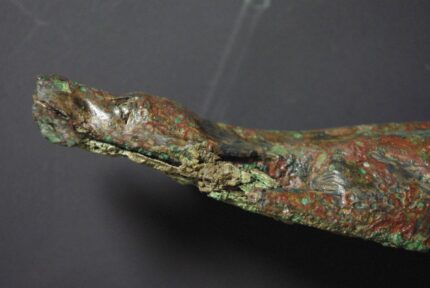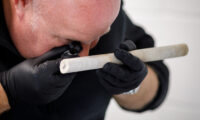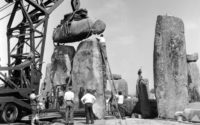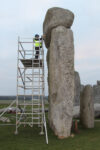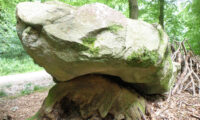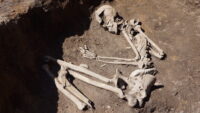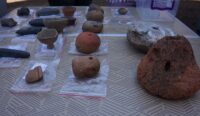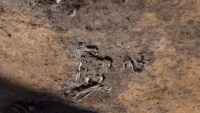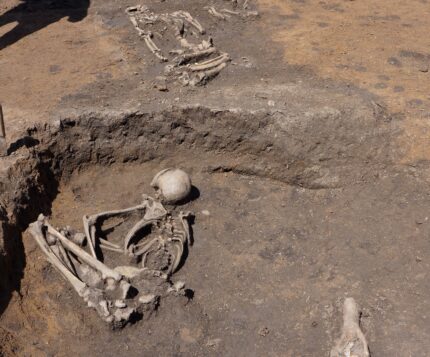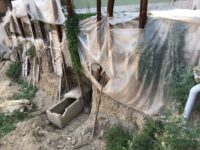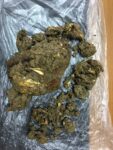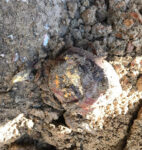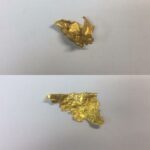One of my all-time favorite stories has an update. In 2015, microbiologists at 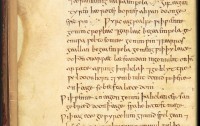 the University of Nottingham collaborated with an Anglo-Saxon expert from the university’s English department to recreate a 10th century recipe for a salve purported to treat eye infections. The combination of onion, garlic, wine and bovine bile steeped together in a bronze or brass vessel was then tested on flourishing cultures of Methicillin-resistant Staphylococcus aureus (MRSA) and found to be a MRSA-killing machine. The individual ingredients did nothing; the control batch minus the vegetable ingredients did nothing. The full salve obliterated 999 Staphylococcus cells in 1,000, both for in vitro cultures and in vivo on infected mice. Even a diluted version of the salve was a powerful weapon. It couldn’t kill MRSA, but it blocked the bacterial cell-cell communication it needs to damage tissue.
the University of Nottingham collaborated with an Anglo-Saxon expert from the university’s English department to recreate a 10th century recipe for a salve purported to treat eye infections. The combination of onion, garlic, wine and bovine bile steeped together in a bronze or brass vessel was then tested on flourishing cultures of Methicillin-resistant Staphylococcus aureus (MRSA) and found to be a MRSA-killing machine. The individual ingredients did nothing; the control batch minus the vegetable ingredients did nothing. The full salve obliterated 999 Staphylococcus cells in 1,000, both for in vitro cultures and in vivo on infected mice. Even a diluted version of the salve was a powerful weapon. It couldn’t kill MRSA, but it blocked the bacterial cell-cell communication it needs to damage tissue.
The results were exciting but the research was in its infancy five years ago. Now the team has published a new paper on the use of Bald’s eyesalve on a range of pathogens in biofilms, communities of bacteria that form a protective shield that is to all intents and purposes impossible to destroy no matter how many antimicrobials you launch at it. Most pharmacological studies of plant ingredients focus on isolating active compounds and using them against planktonic (free-living) bacteria cells which are easier to kill than biofilms. This study explored the antimicrobial properties of the mixture.
Biofilm infections of wounds (e.g. burns, diabetic foot ulcers), medical implants (e.g. artificial joints, catheters), the lungs (e.g. in cystic fibrosis) and other body sites impose a major health and economic burden and can be effectively untreatable. Non-healing, infected foot ulcers, which can be a complication of diabetes, provide an especially sobering example. Even if the infection is apparently successfully treated, there is a high chance of recurrence and an estimated 50% of those affected die within 5 years of ulcer development. Management of diabetic foot ulcers costs the UK’s NHS £650 M per year. […]
Each of Bald’s eyesalve ingredients has known antimicrobial properties or compounds (onion and garlic, bile, wine). We explored the contribution of all four ingredients to both planktonic and biofilm activity of Bald’s eyesalve to build a picture of their relative contributions. Planktonic activity appeared almost entirely attributable to garlic. However, tests against S. aureus Newman biofilms, grown in a synthetic wound model, showed garlic exhibited no antibacterial activity in this more clinically-relevant setting. In fact, no preparation which omitted any one ingredient possessed full activity in the biofilm assay. This confirms our previously published finding that Bald’s eyesalve anti-biofilm activity is contingent on the presence of all four ingredients.
The Voltron force of Bald’s eyesalve was able to completely eradicate planktonic cultures of a number of bacteria including P. aeruginosa, A. baumannii, E. cloacae, S. maltophilia, S. aureus, S. epidermidis, S. pyogenes and MRSA. It was also able to slaughter cells in biofilms S. aureus Newman, A. baumannii and S. pyogenes. Interestingly, while the salve was effective against planktonic cultures of P. aeruginosa, E. cloacae and S. maltophilia, it was ineffective against their biofilms. This discovery underscores how important it is to include biofilms in any studies of antibacterial compounds because being able to kill planktonic cultures bears no relation to being able to break down biofilm.
Because people asked in the comments five years ago (and are still asking today), here’s the recipe for Bald’s eyesalve used by the research team.
Garlic and onions were purchased from supermarkets or greengrocers. As lab work continued throughout all seasons of the year, and was conducted in two locations (Warwick and Nottingham), it is possible that different varieties of garlic and onion, or the same variety grown in different locations, were used in different batches of the eyesalve. The outer skin of the garlic and onion (sourced from local greengrocers) was removed. The garlic and onion were finely chopped, and equal volumes of garlic and onion were crushed together using a mortar and pestle for 2 min. Various sized batches of Bald’s eyesalve were used throughout this paper, ranging from final volumes of 30 ml–400 ml, the average weight used was 14.1 ± 1.5 g of onion and 15.0 ± 1.3 g of garlic per 100 ml of Bald’s eyesalve.
The crushed onion and garlic were then combined with equal volumes of wine (Pennard’s organic dry white, 11% ABV, sourced from Avalon Vineyard, Shepton Mallet) and bovine bile salts (Sigma Aldrich) made up to 89 mg·ml−1 in water and sterilised by exposing to UV radiation for 10 min (Carlton Germicidal Cabinet fitted with a 2537 Å, 8-W UV tube). The mixture was stored in sterilised glass bottles in the dark at 4 °C for 9 days, after which it was strained and centrifuged for 5 min at 1,811 g. The supernatant was then filtered using Whatman 1,001–110 Grade 1 Qualitative Filter Paper, Diameter: 11 cm, Pore Size: 11 μm. Filtered Bald’s eyesalve was stored in sterilised glass vials in the dark at 4 °C.
A little more specific than Oswald Cockayne’s original instructions in the incomparable Leechdoms, Wortcunning, and Starcraft of Early England and not exactly easily reproduced in the home. Still, at least the proportions are there for any adventurous souls.
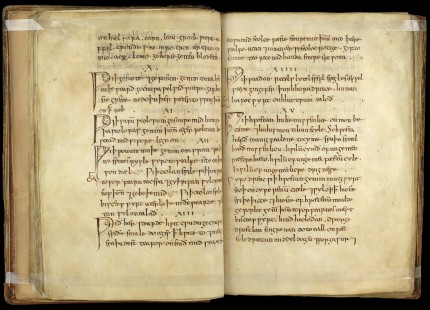
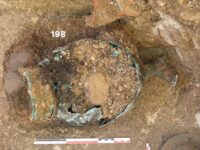 Archaeologists have discovered a rare copper authepsa, a vessel used to heat water, in an excavation around the cathedral of Die in the Drôme department of southeastern France. A team from France’s National Institute for Preventive Archaeological Research (INRAP) was excavating a location on Place de la République where a tree was going to be planted when they unearthed the remains of an ancient building. It was built in the second half of the 1st century and destroyed in a fire at the end of the 2nd century.
Archaeologists have discovered a rare copper authepsa, a vessel used to heat water, in an excavation around the cathedral of Die in the Drôme department of southeastern France. A team from France’s National Institute for Preventive Archaeological Research (INRAP) was excavating a location on Place de la République where a tree was going to be planted when they unearthed the remains of an ancient building. It was built in the second half of the 1st century and destroyed in a fire at the end of the 2nd century.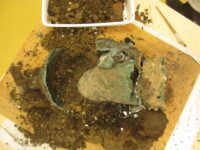 It is 47 cm (18.5 inches) high and consists of two compartments: a reservoir for liquid and a heating chamber. The tank has a capacity of about a gallon and was made of a single very thin (2 mm) piece of copper alloy. The heating chamber runs diagonally from the base of the vessel through the center and is welded to a two-inch hole in the side of the belly through which hot coals were fed to heat the liquid in the reservoir. The opening in the base of the heating chamber is plugged with a copper hemisphere held in place by two transverse iron rods that perforate the base. This blocked the coals from falling out of the chamber while still providing an exit route for the ashes. The vessel was mounted on an annular base with two small square vents.
It is 47 cm (18.5 inches) high and consists of two compartments: a reservoir for liquid and a heating chamber. The tank has a capacity of about a gallon and was made of a single very thin (2 mm) piece of copper alloy. The heating chamber runs diagonally from the base of the vessel through the center and is welded to a two-inch hole in the side of the belly through which hot coals were fed to heat the liquid in the reservoir. The opening in the base of the heating chamber is plugged with a copper hemisphere held in place by two transverse iron rods that perforate the base. This blocked the coals from falling out of the chamber while still providing an exit route for the ashes. The vessel was mounted on an annular base with two small square vents.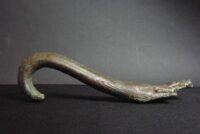 The neck is fashioned into a pouring spout. A cast pouring handle is soldered to the body with a lead-tin mixture. The handle is highly decorative, shaped as dog with his muzzle resting on his front paws. The shape of the vessel and the base is of a type used to heat water for use in personal ablutions. They were easy to carry and could be used out of doors, so it’s also possible it was used to serve a mixture of water and wine.
The neck is fashioned into a pouring spout. A cast pouring handle is soldered to the body with a lead-tin mixture. The handle is highly decorative, shaped as dog with his muzzle resting on his front paws. The shape of the vessel and the base is of a type used to heat water for use in personal ablutions. They were easy to carry and could be used out of doors, so it’s also possible it was used to serve a mixture of water and wine.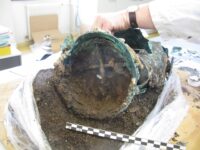 Authepsae of this type are extremely rare. Only six are known to be extant, and this is the second ever found in Gaul. The pot itself can’t be absolutely dated, but the other one discovered in Gaul roughly dates to between the 1st and 3rd century A.D. The unusual dog-shaped handle might held narrow down the date range once it’s cleaned and restored. Some charcoal found in the heating chamber was radiocarbon dated to 130-260 A.D.
Authepsae of this type are extremely rare. Only six are known to be extant, and this is the second ever found in Gaul. The pot itself can’t be absolutely dated, but the other one discovered in Gaul roughly dates to between the 1st and 3rd century A.D. The unusual dog-shaped handle might held narrow down the date range once it’s cleaned and restored. Some charcoal found in the heating chamber was radiocarbon dated to 130-260 A.D.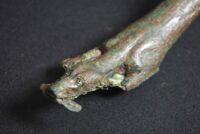 There is archaeological evidence of settlements in the Die area dating back to the Neolithic, but urbanization only kicked off in the 1st century A.D. under Roman rule. By the early 2nd century, Die was a thriving capital of the Gallic Vocontii people and would take on even greater prominence around the turn of the 3rd century as a religious center for the cult of mother goddess Cybele. The authepsa was a luxury item and must have belonged to one of the city’s elite. The room in which it was found had important painted wall decoration, confirming that it was the home of a wealthy person.
There is archaeological evidence of settlements in the Die area dating back to the Neolithic, but urbanization only kicked off in the 1st century A.D. under Roman rule. By the early 2nd century, Die was a thriving capital of the Gallic Vocontii people and would take on even greater prominence around the turn of the 3rd century as a religious center for the cult of mother goddess Cybele. The authepsa was a luxury item and must have belonged to one of the city’s elite. The room in which it was found had important painted wall decoration, confirming that it was the home of a wealthy person.